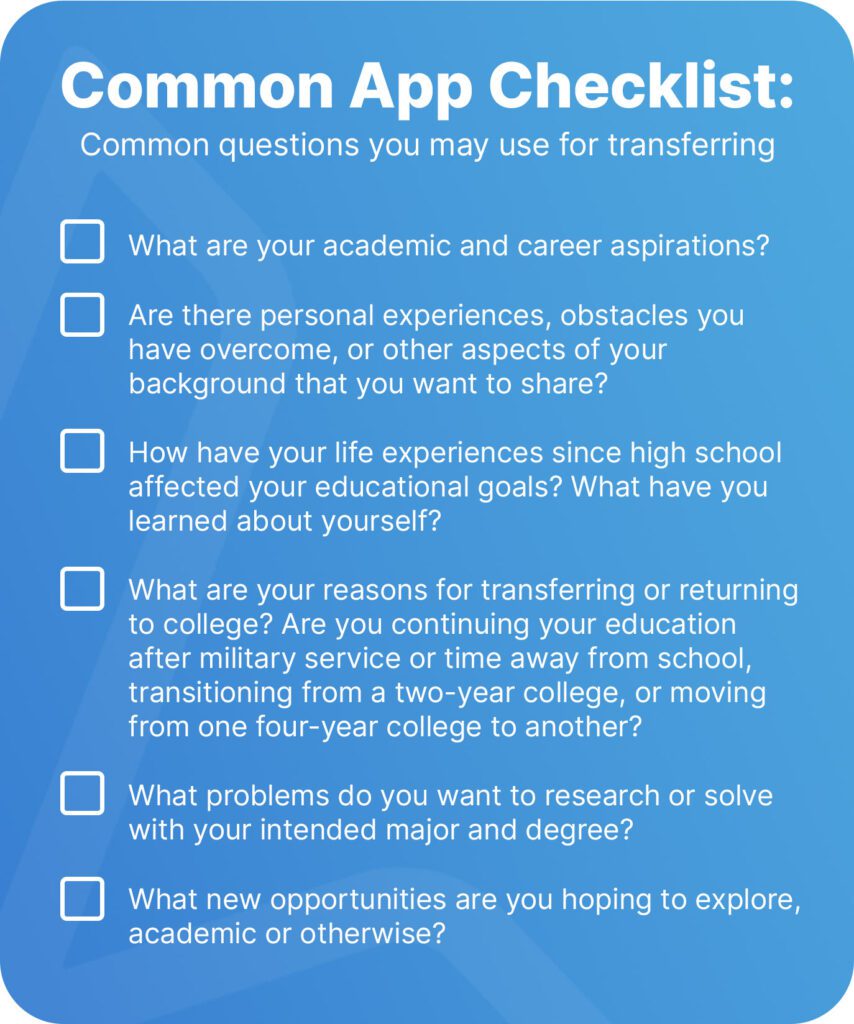
Common App for Transfer Students Guide
If you’re looking to transfer colleges, odds are you’ve probably already used the Common App. Since the Common App makes applying to multiple schools easy, you’ll be pleased to hear that there’s a just as useful Common App transfer application. As long as schools accept the Common App transfer application, you can use one handy tool for all of your schools.
When considering how to transfer colleges, you may feel overwhelmed by the process. However, there are ways to stay organized and prepared in order to streamline your transfer. The Common App transfer option is an excellent way to stay on top of all of your required materials, essays, and deadlines.
In this Common App transfer guide, we’ll cover the following topics:
- Understanding the Common App as a transfer student
- Required materials and how to complete them
- Planning your transfer application and meeting academic requirements
- Obtaining your Common App transfer forms: transcripts, recommendation letters, etc.
- Writing the best Common App transfer essay
- Avoiding common mistakes as a Common App transfer applicant
- Tracking your application status after meeting the Common App transfer application deadline
Before discussing how to transfer colleges using the Common App college application, let’s start with the basics: understanding the Common Application.
What is the Common Application?

The Common Application offers a streamlined process for students in their college application journeys. Before the creation of the Common App 40 years ago, students had to fill out individual applications for each school. The Common Application revolutionized the application process by allowing students to use one platform to apply to multiple schools.
Now with the Common App, students can compile standard application information and a Common App essay to send anywhere. Of course, schools often have their own supplemental essay requirements. Today, more than 1,000 higher education institutions make up the network of Common App colleges.
Common App for Transfers
When looking to transfer colleges, the Common App works in the same way as when applying for the first time. Over 600 institutions allow students to complete their transfer application via the Common App. Whether you’re a community college or 4-year institution transfer applicant, the Common App can work for you! You’ll find plenty of Common App colleges to apply to in one place.
Applicants will be able to organize their Common App transfer forms after creating their Common App transfer login. The process is simple, but you need to gather some important materials prior to creating your Common App transfer login. From there, you can search Common App colleges based on program, transfer application deadline, start date, and more.
Moreover, this platform offers a comprehensive way to stay organized throughout the application process. You can stay on track with your Common App transfer forms, Common App transfer essay, and transfer application deadlines.
If you’re still curious about the difference between the Common App transfer and first-year Common App processes, then check out this page. You might also want to check out this article from U.S. News that covers the Common App in general. Up next, we’ll turn our attention to the all-important Common App transfer essays.
Is there a Common App Essay for Transfers?

Logically, you might be asking yourself if there is a Common App essay for transferring. In fact, you may be surprised to learn that there is no general Common App transfer essay. However, this doesn’t mean that as a transfer student, you’re off the hook with essays.
Instead of a general Common App transfer essay, students will respond to school-specific essay prompts accessed via the Common App. In this way, Common App transfer essays are more similar to supplemental essays than a personal statement. However, some schools may ask students for a personal essay as their Common App transfer essay. If this is the case, students will respond to the personal essay prompts found in the Common App.
Ultimately, the essay requirements will vary based on your schools of interest. You will likely highlight your academic experiences in college rather than high school when applying as a transfer. In addition to your essays, you will need to submit Common App transfer forms. You’ll need to submit a transcript from your current college or university, alongside other materials. We’ll learn more about Common App transfer forms in later sections.
How does the Common App Transfer process work?
Once you have your Common App transfer login, applying to Common App colleges is simple. In fact, the Common App transfer application makes it relatively easy to complete all the necessary application steps. However, it’s certainly important to pay close attention when applying to ensure you don’t miss anything. Let’s look at the Common App transfer process broken down into 5 steps:
5-Step Common App Transfer Process
1. Gather materials
The materials you’ll likely need to include as a transfer applicant are not too different from first-year requirements. In general, you’ll need your transcripts and educational coursework, standardized test scores, employment experience, extracurriculars, and other achievements to complete your application. Of course, required Common App transfer forms may vary depending on the school.
2. Create an account
You won’t be able to do much without first creating your Common App transfer login. After gathering the Common App transfer forms above, create your Common App transfer login. Once you’ve done so, you’ll be able to take advantage of the app and start the application process.
3. Add programs
Now you can search for schools and programs that suit your needs and preferences. Once you enter using your Common App transfer login, simply go to the “Add programs” tab to get started. You can search based on several criteria: program availability, state, college, start term, deadline, application fee, and country. Once you’ve filtered programs based on your criteria, you can add the schools that interest you to your “selected programs.”
4. Request letters of recommendation
Similar to a Common App transfer essay, letters of recommendation play an important role in the admissions process. You can use the Common App transfer to request these letters of recommendation. All you need is the recommender’s name, email, and due date for the recommendation. To get strong recommendation letters, however, you should personally reach out to your recommender to request their support.
5. Transcript collection
Again, the requirements for your transcripts will depend on your program of interest. Some may request official transcripts, others unofficial, and some may require none at all. You can request Common App transfer forms like official transcripts within the Common App.
These are the general steps you’ll need to follow as you begin the application process. Now, let’s take a closer look at the application itself.
The Common App Transfer Application
The Common App transfer application has four sections:
- Personal information
- Academic history
- Supporting information
- Program materials (including school-specific transfer essays or questions)
While this may seem like a lot of information, once you create your Common App transfer login, the process is quite simple. Upon entering your Common Application login details, you’ll be taken to your dashboard. The Common App dashboard has plenty of useful information to help you with your Common App transfer applications.
Past the Common Application login screen, you’ll have access to various college application reference materials and resources. These include a transfer application guide, an application dictionary, and even a library of FAQs and video tutorials. Furthermore, Santa Monica College has provided a useful and informative presentation on the Common App transfer process.
So, if you’re wondering “Should I transfer colleges?”, don’t let the process of transferring be the deciding factor. Simply create your Common App transfer login and start exploring! There are plenty of resources out there to teach you how to transfer colleges seamlessly.
How much does the Common App Transfer cost?

When asking yourself “Should I transfer colleges?”, money may be on your mind. Applying to many schools can be costly, even as a Common App transfer applicant. In fact, the costs are usually the same for transfers as first-time applicants. That being said, application costs and fees vary by school.
Typically, costs are $70-80 per application. However, some schools may have application costs as low as $15 while others as high as $125. Alternatively, some transfer applications are free or have fee waiver options. An advantage of having a Common App transfer login is the ability to see the application fee when searching for programs.
If paying application costs presents a barrier for you, then look into a fee waiver. To counteract recent trends of lower diversity among Common App transfer students, fee waivers are on the rise. There is a Common App fee waiver for qualifying students, so be sure to check the requirements to see if you qualify. Remember, if you’re wondering “Should I transfer colleges?” and are concerned about application fees, don’t let that stop you. There are options out there to make it more affordable.
Determining If the Common App Is Right for Your Transfer

Maybe you’re no longer asking yourself, “Should I transfer colleges?”, but are now asking yourself if you should use the Common App. Well, while the Common App partners with over 600 transfer colleges, not every school uses the Common App. Other schools may use a different application platform or have their own transfer application. Therefore, the schools you’re interested in will play the largest role in which applications you’ll use.
Common vs Coalition Application
Alongside the Common App, the Coalition App is another application platform transfer students can use. However, it is uncommon for a school to accept only the Coalition App and not the Common App; typically, both are accepted. For example, Harvard University accepts either the Coalition Application or the Common Application. In this case, you may choose to use Coalition on Scoir, especially if you did so as a first-year applicant. Of course, similar to the Common App transfer forms, the Coalition App will have different requirements for transfer applications.
School-specific transfer applications
Alternatively, some schools may have their own platform for transfer students. In that case, you won’t be making a Common App transfer login but one for that individual school. For example, the University of California schools have their own application platform for first-years and transfers. Similarly, the University of Texas at Austin accepts applications via Apply Texas, which many Texas universities use. MIT is another school that has its own application portal for transfer students.
Why Common App?
Some students may find that they are leading hectic lives. Transfer students are often in school or may even be working part- or full-time with families to support. Therefore, if you are in a similar position and wondering, “Should I transfer colleges?”, then the Common App transfer can certainly streamline the process.
Among the resources that the Common App offers, the Common App map is an important one. Students can look at a map of American schools that accept the Common Application. As such, you won’t have to create a myriad of logins to complete your application, you’ll simply use the Common Application login. It makes the process quicker and often less stressful.
Preparing Your Documents
If asking how to transfer colleges, then obtaining the required materials is a large part of the answer. Once you create a Common Application login, you’ll see the list of Common App transfer forms and other required materials. Remember that you can also see transfer application deadlines for all Common App colleges. So, when organizing your transfer application timeline, keep those important dates in mind.
Here are some of the materials you’ll need to prepare for your application:
Materials for Transfer Application
Transcripts
Transcripts are important because they show your courses and grades. Schools may ask for an official or unofficial transcript. You can request an official transcript from your school through the Common App platform. Note that you likely won’t need to submit a high school transcript unless you have fewer than 12 college credits. If you’re unsure how many credits you have, your college registrar’s office can probably help.
College reports
An official at your current institution of learning must fill out your college report. It will contain your GPA and information on your current academic standing.
Mid-term reports
Some schools may also ask for a mid-year report. It will have your grades from the previous semester, the ones you were completing while also doing your applications. Note that while this is a common requirement, not all schools ask for it.
CV/Resume
A CV or resume will include not only prominent academic achievements, but also extracurriculars, volunteer experiences, hobbies, and any other accolades. As a transfer student, you may also have ample work and leadership experience. You should include it here. Most college career services offices provide resume writing support, so don’t be afraid to ask for help.
Green card
Additionally, if you’re a foreign resident in the U.S., you will need proper documentation to continue further education in the country. As a transfer student, this means providing proof of your valid green card or student visa.
Recommendations
One of the Common App transfer forms that ranks similarly in importance to the Common App transfer essay is the recommendations. Choose your recommenders carefully, as these letters provide admissions officers with a deeper insight into you as a person and student. And of course, give your recommenders plenty of time to meet the deadline and a hearty thank you!
Once you have a Common App login, however, requesting and submitting these documents to your transfer colleges is quite simple. Now, let’s turn our attention back to your transfer essays.
Crafting a Compelling Common App Transfer Essay

Remember, there is technically no general Common App transfer essay like the Common App personal statement. Rather, each school will likely have their own supplemental essays for transfer students. However, you may be asked to write a Common App personal essay as a transfer student.
Essays are extremely important whether a first-year or transfer applicant. A compelling Common App transfer essay will make a case for your acceptance as a transfer student. Here are some questions that a successful Common App transfer essay will answer:
Questions to Answer in Common App Transfer Essay
“Why do you want to leave your current institution?”
Address what your previous institution was lacking. Why wasn’t it a good fit? Be careful not to be overly negative or critical of your school in this essay. Focus on yourself and why you want to seek greener pastures.
“Why do you want to transfer to a new institution?”
Articulate why you want to attend this particular school. What attracts you to it? Why is it a better fit? Be specific in writing about the new school and how transferring will help you achieve your goals.
“What makes you a strong candidate?”
Think about what makes you unique. What are your goals, strengths, and interests? How will you contribute to your new community? Use strong, concrete examples, preferably of achievements at your current institution.
Common App Transfer Essay Tips
The Common App transfer essay also provides the following topics for students to engage with in their essays. Here are some of the points that the Common App recommends transfer students touch on in their Common App personal essay:
- Academic and career aspirations
- Personal experiences, overcoming obstacles, other pertinent background information
- Growth and personal development from life experiences since high school—what have you learned about yourself and how have these experiences affected your educational goals?
- Reasons for transferring or returning to college
- Major-specific interests—what type of research would you want to conduct? Are there specific problems you’d like to investigate?
- Opportunities you’re hoping to find at your new institution
The Common App transfer essay and/or school-specific essays are a vital part of your transfer application. When considering how to transfer colleges, writing impressive essays should play a role in your plan to get into your dream school. Check out our guide on the Common App transfer essay to see some examples of successful transfer essays.
Does the Common App have supplemental essays for transfer students?
Put simply, yes, the Common App has supplemental essays. These are often different from the first-year Common App essay and will vary based on the program you’re applying to. To find these essays, use your Common Application login to enter the site. Then, go to your dashboard, then navigate to Program Materials. Select your school and then look at the Questions section. Here, you will find the school-specific essay prompts you’ll need to complete.
As a transfer student, you will need to complete either the Common App essay or school-specific supplemental essays. Every school is different, so your essay requirements will depend on the schools you plan to apply to. For example, Case Western Reserve asks students to submit a personal statement essay, choosing from the Common App essay prompts. However, Claremont McKenna asks applicants to submit three supplemental essays, responding to school-specific prompts.
Highlighting Your College Experience in the Common App

While the application process as a transfer student appears quite similar to a first-year applicant, there are subtle differences. Namely, the main difference between a transfer and a first-year college application is that transfer applicants need to highlight college experiences. Admissions will want to see that you’ve made the most of your education at your current institution. And, if for some reason you haven’t, they’ll want to know the circumstances behind that.
So, when considering how to transfer colleges, you’ll want to think about highlighting important experiences within your application. Here are some different areas within the application that will give you an opportunity to show off what you’ve done:
Sections to Highlight Your Experience
Academic History section
In this section, you’ll mention the colleges you’ve attended as well as your college coursework. This will show admissions if you’ve completed the required courses and if you’re up for taking challenging courses later on. It may also be important when applying to certain majors. For example, as a biology major, admissions would want to see you’ve taken the basic requisites.
Supporting Information section
Now is the time to add all the information that admissions can’t see by simply looking at your academics. You’ll add your experiences and achievements, like extracurricular activities, leadership positions, and awards. You can also attach a CV or resume where you can show off your work, life, academic, and personal experiences.
Essays
Without a doubt, your essays are your best opportunity to discuss your college experience in your own words. You might discuss highs and lows, both in and out of the classroom. It’s also an opportunity to expand on your future goals and why you need to transfer in order to achieve them. Well-written transfer essays will touch on the past as well as the future. And, of course, they need to be personal and school-specific.
Now that we’ve covered the basics of the Common App transfer application and the Common App essay, let’s discuss your transcripts. Later on, we’ll do a deep dive into your letters of recommendation.
High School Transcripts and Transfer Applications

Transcripts are a critical part of the admissions review process at most every college. Typically, traditional first-year applicants are required to submit their high school transcripts. Similarly, Common App transfer applicants are required to submit their college transcripts. However, in some instances, schools may want to see both.
Transcript requirements
Typically, students with less than 12-semester college credits will need to submit a high school transcript. This is because a low number of college credits doesn’t provide sufficient academic context to the admissions committee. In this case, a college’s admissions requirement will likely include your high school transcript and maybe even your standardized test scores, like the SAT or the ACT.
However, certain colleges require all transfer applicants, regardless of completed college credits, to submit both their high school and college transcripts. Common App transfer requirements can vary by college and even by major. So, it is important to research which transcripts are required to complete your application based on your individual circumstances.
For instance, if you are a transfer student who has attended more than one college, you will be required to submit all transcripts when completing your Common App transfer application. Failure to submit all required transcripts may lead to your application being rendered incomplete. Using your Common App transfer login to continuously check your requirements can help you stay organized and informed.
Recommendation Letters: Tips for Transfer Students

Alongside your Common App transfer essay, your recommendation letters are one of the most valuable components of your transfer application. Common App transfer recommendations must be submitted directly by recommenders via a portal called Liaison Letters.
The Liaison Letters portal is separate from your Common App transfer login information. In fact, only your recommenders will be able to access Liaison Letters. However, students will need to request recommendations via the Program Materials section of their college application for each school they are applying to.
Who to ask for recommendation letters
The art of a successful Common App transfer recommendation is knowing who to ask for a recommendation. You should start by making a list of multiple people that you have a real relationship with or who showed a real interest in you. This can include professors, administrators, advisors of a club or organization, coaches, or supervisors.
Ultimately, you’ll want to choose someone who knows you in an academic, professional, or extracurricular capacity. While personal recommendations from family and friends can often speak to your character, these recommendations are not particularly helpful for an admissions committee evaluating Common App transfer applications. It is also important that you focus on college recommenders and not those from high school.
Depending on how long you have been at your current institution, you may find that you have fewer long-standing relationships with your instructors compared to what you had in high school. Some transfer students at larger schools may even feel like they have no one who knows them well enough to write a recommendation letter. If this sounds like you, do your best to forge meaningful relationships with faculty, even if it’s only your first year in college. You can do this organically by visiting professors during office hours and participating in clubs and organizations.
When to ask for recommendation letters
Like when you applied as a first-year applicant, applying as a transfer student takes a great deal of organization and deadline management. It can often be difficult to manage deadlines for yourself. However, it’s important to remember that you are also managing deadlines for the professors who will ultimately write your letters of recommendation.
To give your recommenders ample time, it is important to request recommendations no later than six weeks prior to your application date. This will give your recommenders plenty of time to consider your request, write the recommendation, and submit the recommendation letter through the preferred platform.
How to submit recommendation letters
Common App transfer applicants should instruct their professors to submit recommendation letters through Liaison Letters. Once you’ve requested them in your Common App portal, your recommender will receive an email invitation that grants them personalized access to the platform.
However, as part of your request for a letter of recommendation, you should also make sure that your recommenders have access to the platform and any other necessary Common App transfer forms. That means checking in with them and ensuring you have the correct name, email address, and any other contact information needed to request your recommendations.
At any time, you can use your Common Application login to check the status of your recommendation letters. The status area of the webpage will show exactly where your recommendations are in the process.
If your Common App transfer recommendation has not moved past the requested, you should follow up with your recommender immediately to prompt them to complete the Common App transfer forms. This may be a sign that your Common App transfer recommendation invitation did not reach your recommender. The status of your Common App transfer recommendations should complete all three steps:
Requested→Accepted→Complete
Once your Common App transfer recommendation letter reaches the Complete step, your recommendation has been successfully completed.
The Transfer Academic Evaluation

Now that we’ve discussed the required Common App transfer forms, let’s discuss how your academic performance is evaluated.
Minimum GPA requirements
It is common for schools to have a minimum GPA requirement for transfer applicants. After all, your future institution is looking for evidence that you will be successful on their campus should you transfer colleges. Consequently, your academic transcript is one of the most important documents in determining whether you will be an academic fit for the institution.
However, don’t mistake meeting the minimum GPA requirement for guaranteed admissions. While Common App transfer schools often publish their minimum GPA requirements, you may find that accepted transfer students tend to have even higher GPAs than the published averages. If you want to see how your GPA compares, reach out to your admissions counselor or look online to learn more about the admitted student profile for transfer students.
Academic success
Transfer colleges are looking for students who have done well in their college coursework. This demonstrates dedication to studies and readiness to tackle the rigorous challenges of college-level courses. However, the academic evaluation for transfer students will vary from school to school. The selectivity of a school or your specific major of interest can both influence how transcripts are reviewed.
For one, you may be asking yourself, “Should I transfer colleges?” because you’re doing so well in your courses and you need more of a challenge. In this case, your grades will positively reflect your academic success! However, not getting As in your most challenging courses shouldn’t deter you from submitting a transfer application to more selective universities. If you’re applying yourself, and provide context in a stellar Common App essay, you can definitely still demonstrate your academic achievements.
Ultimately, understanding what your future college expects academically can help you determine if they are the right fit for you.
Exploring the Common App Schools: Finding the Right Fit

Finding the right fit college is one of the most important parts of the college search process. Whether you are seeking to transfer due to dissatisfaction with your first institution or as part of a strategic plan to enroll in your dream school, your future institution should suit your preferences, needs, and goals.
Consider the “why”
Many students find themselves asking “should I transfer colleges?” The next question to ask before submitting a Common App transfer application is “why should I transfer colleges?”. Being clear on the reasons you want to transfer is a great way to find transfer colleges that are a good fit. You may consider features like research opportunities, student life, student-to-faculty ratio, and available majors.
Common App transfer colleges will also ask you why you are interested in transferring as part of your Common App transfer essays. Developing a list of reasons you want to transfer will also help you in this process.
Do your research
Finding a school that’s the right fit requires you to reflect on campus size, region, institutional type, academic major, and student life. In your research, do not limit yourself to only considering the Common App colleges that you have heard of. There are hundreds of Common App colleges in the U.S. that could be a good fit for you. A great way to learn of all the possible options is to browse Common App’s list of transfer schools, taking note of details like location, student life, and majors and programs.
Furthermore, a college’s website is the best place to get the most up-to-date information on their transfer application deadlines, academic programs, and policies. In addition to doing a thorough website review, there may be an opportunity to participate in a virtual tour or virtual information. A virtual visit option is great for students who live far away from the transfer colleges they are considering.
Transfer logistics
It is also important to know the starting term (Fall vs Spring, etc.) and how that fits into your overall transfer plan. Additionally, your academic major and program can also influence whether a school is a good fit for you.
Many transfer institutions have additional rules around transferring into certain majors. Remember, transfer admissions are often based on availability. So, if your major is popular, it is possible that the department is not taking additional students. It’s always a good plan to inquire specifically about transferring into your intended major.
Once you have a preliminary list of schools, you should plan to use your Common Application login to double-check deadlines, requirements, application costs, and entry terms. That way, you can plan a more seamless Common App transfer application. The next section will discuss more about getting and staying organized during the application process.
Planning Your Transfer Application

Completing a transfer application for Common App colleges takes time. To stay organized, you may want to create a college application calendar that has a list of To-Do’s. This might include when you want to have each step completed, as well as your final application deadlines.
Keeping your Common App transfer login information and any other Common Application login credentials handy will also allow you to check your portal frequently. Required Common App transfer forms may vary depending on the institution. Staying organized will help ensure that your Common App transfer essay and any other Common App transfer forms are given the time and attention they deserve.
In general, be sure to give yourself ample time to refine your Common App transfer essay and other Common App transfer forms. That way, you can stay on top of all of your transfer application deadlines.
Common App Transfer Deadlines
Your Common App transfer colleges will either have one set deadline or participate in rolling admissions. Deadlines for Fall admission can be as early as March and for some schools as late as August. You should pay close attention to each of the deadlines for the Common App colleges on your list.
Rolling admissions means there are no official transfer application deadlines or notification dates. Instead, Common App transfer applications are reviewed as they are received. Acceptance under rolling admission is highly dependent on availability on campus. If there is a Common App transfer college that has rolling admissions on your college list, be sure to submit your college application as soon as possible. The admissions team is often working to fill individual seats, and once those seats are filled, they may not be accepting any additional college applications.
Students should always confirm the transfer application deadline of their specific school and the desired start term. For transfer students, this process typically includes bypassing registration for the upcoming term at your current institution. If deadlines and start terms are overlooked, you may have to stay enrolled at your current institution longer than you originally planned.
Learning how to transfer colleges can be a confusing process. Next, we’ll discuss some common mistakes to avoid when completing your Common App transfer college application.
Common Mistakes to Avoid in Your Transfer Application

Like the first-year college application process, there are many common mistakes you can make when it comes to your Common App transfer forms and overall application.
Managing communications
One mistake that students might make is using an email address that they do not check regularly. In addition to your Common App transfer login, your email is a critical way for you to stay up to date on your application. Learning how to transfer colleges requires a great deal of organization and attention to email communications.
Students should become very comfortable with the Common App platform and required Common App transfer forms. This means keeping track of your Common App transfer login and the status of each of your materials. Because the recommendation process requires an email invitation, you should be sure that you are communicating properly with each of your recommenders.
To avoid missing important communications, you might consider creating a dedicated email to use for your Common Application login and any other portals associated with your Common App transfer login.
Polishing your essays
Writing effective Common App transfer essays is another part of the application process that many students struggle with. Your Common App essay should be free of typos and grammatical errors. You also want to be sure that your Common App transfer essay does not speak too negatively about your current intuition. In the Common App transfer essay, students must be able to articulate why they are looking to transfer without harping on why their current school is subpar.
To submit a strong Common App transfer essay, you should proofread your Common App essay multiple times, even reading it out loud to catch any grammar mistakes. We also recommend sending your Common App essay to at least one other person for them to review it.
Overall, being organized and planning ahead will help you avoid careless mistakes, like missing a deadline or neglecting to pay your application fee. Your Common App transfer login will also help you track your application and avoid some of these mistakes.
Tracking your application after submission
The Common App transfer portal makes it easy to track your application status at all of your Common App colleges. All you need to check your status is your Common App transfer login. You can view the progress of your Common App transfer application by visiting the application dashboard and clicking ‘view my notifications’.
Remember, submitting your Common App transfer application is just the first step. You may have to submit additional Common App transfer forms for your transfer application to be considered complete.
The Common App transfer status portal divides your transfer application into three areas: application, transcript, and recommendation letters. Here are some of the different types of statuses you should be aware of:
Important application statuses
- Application: The application portion of the Common App status portal is divided into four status updates: In Progress, Received, Complete, and Undelivered. Your application will be considered complete once you’ve submitted your application, and your recommenders have submitted their recommendations. and your application fee payment has been processed.
- Transcript: You can submit your transcripts electronically or by mail. Regardless, students can track the progress of their transcripts based on three status updates: Not Required, Not Arrived, and Arrived. In general, it can take five business days for your transcripts to be posted to your application once they have been received by Common App. So, be sure to check for any unexpected delays.
- Recommendations: The recommendation portion of the Common App transfer portal helps you assess the progress of your recommendations. As you may recall, Common App Transfer recommendations are directly tied to a personal email invitation. While you won’t be able to access your recommendations, you are still responsible for ensuring they are completed. The status stages for Common App transfer recommendations include Requested, Accepted Completed, Declined, and Expired.
It is critical that you stay up to date on each of these Common App transfer materials so that you are prepared to meet all of your transfer application deadlines.
Five Takeaways for Common App Transfer

At this point, we’ve covered a lot about the Common App transfer process and how to transfer colleges. Before we wrap up, let’s review five important takeaways:
Common App Transfer Takeaways
- The Common App transfer application makes it easy for students to apply as a transfer student to multiple colleges. The application itself is split into four sections: Personal Information, Academic History, Supporting Information, and Program Materials.
- You can browse and add programs that best fit your needs. Schools are listed with details such as start terms, deadlines, and application fees. Once selected, you can then view the individual requirements of each school. Before you apply, be sure to ask yourself “Why should I transfer colleges?” This will be helpful when you begin the school selection process.
- The Common App transfer application is generally not free. While select schools accept applications at no cost, transfer application fees are typically $70-$80. However, students who qualify can apply for fee waivers at some institutions.
- One of the more significant portions of the transfer application is the writing section. You may be required to respond to the Common App Personal Statement prompts or school-specific Common App transfer essay prompts.
- You will need to submit required documents, such as transcripts and recommendations using your Common App transfer login. Carefully complete each step to ensure your documents are properly submitted before the transfer application deadline.
Still, have questions on how to transfer colleges? Don’t forget to use your Common App transfer login to visit the Common App for transfer Help Center for more helpful information.
Common App for Transfer Students – Final Thoughts
The Common App transfer application provides an organized platform for transfer students to explore and apply to transfer colleges. Before applying, students should reflect deeply on the following questions: “Should I transfer colleges?” and “Why do I want to transfer colleges?”. This self-reflection will help you compile a list of potential transfer colleges that are a good fit for you.
Submitting a Common App transfer application also involves a great deal of organization and time management. Staying organized can help you submit a strong transfer application that includes compelling letters of recommendation and a thoughtful Common App transfer essay. In addition to these requirements, be sure to use your Common Application login to make sure you are up to date on submitting any required Common App transfer forms.
We hope this guide on how to transfer colleges through Common App has been helpful. However, if you ever get stuck on the Common App transfer application, don’t hesitate to reach out for more personalized guidance! CollegeAdvisor can help you navigate the Common App transfer process, from researching alternative institutions all the way to tracking your application to completion.

This article was written by Sarah Kaminski and Chelsea Holley. Looking for more admissions support? Click here to schedule a free meeting with one of our Admissions Specialists. During your meeting, our team will discuss your profile and help you find targeted ways to increase your admissions odds at top schools. We’ll also answer any questions and discuss how CollegeAdvisor.com can support you in the college application process.
